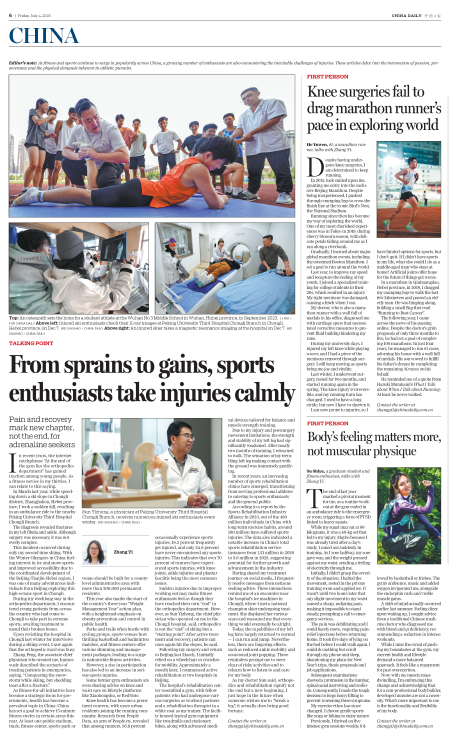
Zhang Yi
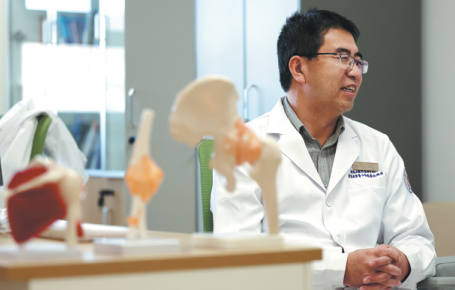
Sun Yizhong, a physician at Peking University Third Hospital Chongli Branch, receives numerous injured ski enthusiasts every winter.
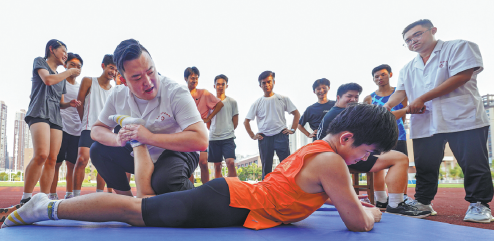
An osteopath sets the bone for a student athlete at the Wuhan No 3 Middle School in Wuhan, Hubei province, in September 2023.
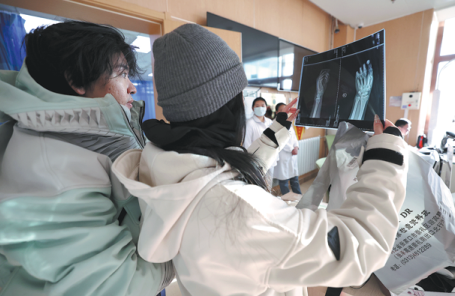
Injured ski enthusiasts check their X-ray images at Peking University Third Hospital Chongli Branch in Chongli, Hebei province, on Dec 7.
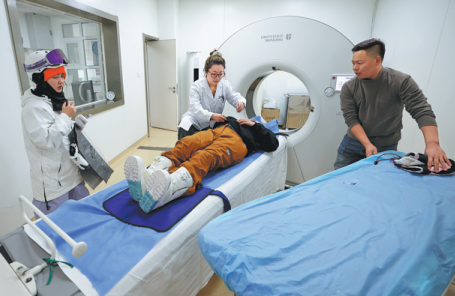
An injured skier takes a magnetic resonance imaging at the hospital on Dec 7.
Editor's note: As fitness and sports continue to surge in popularity across China, a growing number of enthusiasts are also encountering the inevitable challenges of injuries. These articles delve into the intersection of passion, perseverance and the physical demands inherent in athletic pursuits.
In recent years, the internet catchphrase "At the end of the gym lies the orthopedics department" has gained traction among young people. As a fitness novice in my thirties, I can relate to this saying.
In March last year, while speeding down a ski slope in Chongli district, Zhangjiakou, Hebei province, I took a sudden fall, resulting in an ambulance ride to the nearby Peking University Third Hospital Chongli Branch.
The diagnosis revealed fractures in my left fibula and ankle. Although surgery was necessary, it was not overly complex.
This incident occurred during only my second time skiing. With the Winter Olympics in China fueling interest in ice and snow sports and improved accessibility due to the coordinated development of the Beijing-Tianjin-Hebei region, I was one of many adventurous individuals from Beijing exploring this high-octane sport in Chongli.
During my weeklong stay in the orthopedics department, I encountered young patients from across the country who had come to Chongli to take part in extreme sports, awaiting treatment to mend their broken bones.
Upon revisiting the hospital in Chongli last winter for interviews during a skiing event, I saw again that the orthopedic ward was busy.
Zhang Peng, the associate chief physician who treated me, humorously described the scenario of treating patients in emergencies, saying, "Conquering the snowstorm while skiing, but shedding tears after a fracture."
As fitness-for-all initiatives have become a strategic focus for governments, health has become a prevalent topic in China. China has set a goal to achieve 15-minute fitness circles in certain areas this year. At least one public stadium, track, fitness center, sports park or venue should be built for a county-level administrative area with more than 200,000 permanent residents.
This year also marks the start of the country's three-year "Weight Management Year" action plan, with a heightened emphasis on obesity prevention and control in public health.
Parks and trails often bustle with cycling groups, sports venues host thrilling basketball and badminton matches, and fitness centers offer various slimming and management packages, leading to a surge in nationwide fitness activities.
However, a rise in participation has also led to an increase in serious sports injuries.
Some former gym enthusiasts are even sharing advice on knee and waist care on lifestyle platforms like Xiaohongshu, or RedNote.
Knee health has become a prominent concern, with more urban residents joining the running community. Research from People Data, an arm of People.cn, revealed that among runners, 56.9 percent occasionally experience sports injuries, 18.2 percent frequently get injured, and only 24.9 percent have never encountered any sports injuries. This indicates that over 70 percent of runners have experienced sports injuries, with knee joints, ankle injuries and plantar fasciitis being the most common issues.
Sudden injuries due to improper working out may make fitness enthusiasts feel as though they have reached their own "end" in the orthopedics department. However, as Sun Yizhong, the chief physician who operated on me in the Chongli hospital, said, orthopedics is not the "end" of skiing but a "starting point". After active treatment and recovery, patients can once again hit the slopes, he said.
Following my surgery and return to Beijing last March, I initially relied on a wheelchair or crutches for mobility. Approximately a month later, I commenced active rehabilitation at two hospitals in Beijing.
The hospital's rehabilitation center resembled a gym, with fellow patients who had undergone various surgeries as workout partners and a rehabilitation therapist in a white coat as my trainer. The facility housed typical gym equipment like treadmills and stationary bikes, along with advanced medical devices tailored for balance and muscle strength training.
Due to my injury and post-surgery movement limitations, the strength and stability of my left leg had significantly weakened. After nearly two months of training, I relearned to walk. The sensation of my trembling left leg making contact with the ground was immensely gratifying.
In recent years, an increasing number of sports rehabilitation clinics have emerged, transitioning from serving professional athletes to catering to sports enthusiasts and the general public.
According to a report by the Sports Rehabilitation Industry Alliance in 2023, out of the 430 million individuals in China with long-term exercise habits, around 100 million have suffered sports injuries. The data also indicated a notable increase in China's total sports rehabilitation service instances from 1.51 million in 2020 to 3.6 million in 2023, suggesting potential for further growth and advancement in the industry.
Having shared my treatment journey on social media, I frequently receive messages from netizens seeking advice. These interactions remind me of an encounter near the hospital's ice machines in Chongli, where I met a national champion skier undergoing treatment. She displayed her various scars and reassured me that everything would eventually be alright.
Today, the capabilities of my left leg have largely returned to normal — I can run and jump. Nevertheless, there are lingering effects, such as reduced ankle mobility and occasional joint popping. These reminders prompt me to steer clear of risky activities and to relearn how to listen to and care for my body.
As my doctor Sun said, orthopedics and rehabilitation signify not the end but a new beginning. I just hope in the future when someone wishes me to "break a leg", it actually does bring good fortune.
Contact the writer at zhangyi1@chinadaily.com.cn
